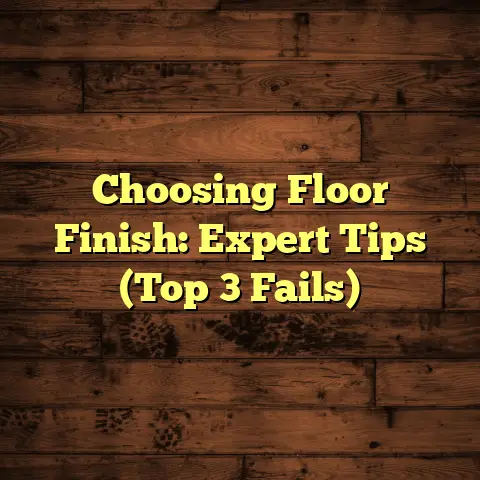Wood Floor Over Carpet? (3 Subfloor Fails!)
We’re living in a world where everyone’s looking for the quickest, easiest, and most cost-effective solution. And when it comes to flooring, that can sometimes lead to… well, let’s just say interesting choices.
I’m talking about the idea of installing wood flooring directly over carpet. Sounds tempting, right? Save time, save money, instant upgrade! But trust me, as someone who’s seen the aftermath of these decisions, it’s often a recipe for disaster.
Future-proofing your home is about more than just the here and now. It’s about making choices that will stand the test of time, both aesthetically and structurally. In this article, we’re going to break down why installing wood flooring over carpet is almost always a bad idea, focusing on the hidden subfloor issues that can completely undermine your investment.
I’ll share real-world examples, industry insights, and practical advice to help you make informed flooring decisions. Let’s get started!
Section 1: Understanding the Concept of Wood Floor Over Carpet
So, what exactly does it mean to install wood flooring over carpet?
Simply put, it’s the process of laying down a wood or wood-like flooring material (like engineered wood or laminate) directly on top of existing carpet, without removing the carpet first.
Why would anyone consider doing this? Well, there are a few reasons that often pop up:
- Convenience: Ripping up carpet is a pain! It’s messy, time-consuming, and can expose all sorts of hidden horrors underneath. Covering it up seems like a much easier solution.
- Cost-Effectiveness: Removing carpet often involves additional costs like disposal fees and subfloor repairs. Skipping this step can seem like a budget-friendly option.
- Aesthetic Appeal: Let’s face it, carpet can look dated and worn. Wood flooring offers a more modern and sophisticated look, instantly upgrading the appearance of a room.
Now, what kind of wood flooring are we talking about here? Typically, when people consider this route, they’re looking at either engineered wood or laminate flooring.
- Engineered Wood: This consists of a thin layer of real wood veneer bonded to a core of plywood or high-density fiberboard (HDF). It’s more dimensionally stable than solid wood, making it less prone to warping and expansion/contraction due to moisture changes.
- Laminate: This is a synthetic flooring material made of multiple layers, including a high-resolution image of wood grain on the surface. It’s durable, scratch-resistant, and often more affordable than engineered wood.
While these materials can be installed as floating floors (meaning they’re not glued or nailed down), that doesn’t automatically make them suitable for installation over carpet. And that’s where the problems start!
Section 2: The Importance of the Subfloor in Flooring Installation
Before we dive into the specific fails, let’s talk about the unsung hero of any flooring project: the subfloor.
What exactly is a subfloor? It’s the foundation upon which your finished flooring is installed. Think of it as the backbone of your flooring system. It provides a stable, level, and solid surface to support the flooring material and everything that goes on top of it.
There are several types of subfloors you’ll typically encounter:
- Concrete: Common in basements and slab-on-grade construction. Concrete subfloors are durable and resistant to moisture, but they can also be cold and hard.
- Plywood: A popular choice for above-grade construction. Plywood is strong, lightweight, and provides a good surface for nailing or gluing flooring.
- Oriented Strand Board (OSB): Similar to plywood but made from compressed wood strands. OSB is often more affordable than plywood, but it’s also more susceptible to moisture damage.
The subfloor plays a crucial role in the overall performance and longevity of your flooring. Here’s why it matters:
- Moisture Control: A properly installed subfloor can help prevent moisture from seeping up from the ground or below, protecting your flooring from damage.
- Sound Insulation: A dense and solid subfloor can help dampen sound transmission between floors, making your home quieter and more comfortable.
- Structural Integrity: The subfloor provides the necessary support to prevent your flooring from flexing, bouncing, or cracking underfoot.
Think of your flooring project as a house. The subfloor is the foundation. If the foundation is weak or unstable, the entire house is at risk. And that’s exactly what happens when you try to install wood flooring over carpet.
Section 3: Fail #1 – Inadequate Support and Stability
Alright, let’s get into the nitty-gritty. The first, and perhaps most obvious, problem with installing wood flooring over carpet is inadequate support and stability.
Carpet, by its very nature, is a soft and compressible surface. It’s designed to cushion your feet, not to provide a rigid base for a hard flooring material. When you install wood flooring over carpet, you’re essentially laying it on a giant sponge.
Here’s what happens:
- Uneven Surface: Carpet is rarely perfectly level. It can have dips, bumps, and variations in thickness, creating an uneven surface for your new flooring.
- Compression: Carpet padding is designed to compress under pressure. When you walk on the wood flooring, the carpet underneath will compress, causing the flooring to flex and move.
- Lack of Support: Wood flooring needs solid, consistent support to prevent it from bending or breaking. Carpet simply doesn’t provide that level of support.
The implications of this inadequate support can be significant:
- Squeaking and Creaking: As the wood flooring flexes and rubs against the carpet, it can create annoying squeaks and creaks that drive you crazy.
- Joint Separation: The constant movement can cause the joints between planks or tiles to separate, creating unsightly gaps and potential tripping hazards.
- Cracking and Breaking: In extreme cases, the lack of support can cause the wood flooring to crack or break, especially in high-traffic areas.
I remember one particular case where a homeowner insisted on installing laminate flooring over shag carpet in their living room. Within a few months, the flooring was squeaking like crazy, the joints were separating, and several planks had cracked. They ended up having to rip everything out and start from scratch, costing them way more time and money than if they had just removed the carpet in the first place.
Don’t let this happen to you!
Section 4: Fail #2 – Moisture Buildup and Damage
The second major problem with installing wood flooring over carpet is moisture buildup and damage.
Carpet is notorious for trapping moisture. Whether it’s from spills, humidity, or even just everyday foot traffic, carpet tends to absorb and retain moisture like a sponge.
When you cover that moisture-laden carpet with wood flooring, you’re creating a perfect breeding ground for mold, mildew, and rot.
Here’s how it works:
- Trapped Moisture: The carpet acts as a barrier, preventing moisture from evaporating.
- Lack of Ventilation: The wood flooring further restricts airflow, creating a damp and stagnant environment.
- Organic Material: Carpet is made of organic materials that provide a food source for mold and mildew.
The consequences of this moisture buildup can be severe:
- Mold and Mildew Growth: Mold and mildew can grow rapidly in damp, dark environments, causing unpleasant odors and potential health problems.
- Rotting Subfloor: The moisture can seep into the subfloor, causing it to rot and weaken, compromising the structural integrity of your home.
- Damaged Flooring: The moisture can cause the wood flooring to warp, buckle, and delaminate, ruining its appearance and structural integrity.
According to the EPA, mold can cause a variety of health problems, including:
- Nasal stuffiness
- Throat irritation
- Coughing or wheezing
- Eye irritation
- Skin irritation
I’ve seen countless cases where homeowners have discovered extensive mold and mildew growth under their wood flooring after installing it over carpet. In some cases, the damage was so severe that they had to completely gut the room and remediate the mold before they could even think about installing new flooring.
The key takeaway here is that moisture is the enemy of flooring. And installing wood flooring over carpet is practically inviting moisture problems into your home.
Section 5: Fail #3 – Compromised Floor Height and Transition Issues
The third, and often overlooked, problem with installing wood flooring over carpet is compromised floor height and transition issues.
When you add a layer of wood flooring on top of a layer of carpet, you’re inevitably raising the floor height. This can create a number of aesthetic and practical challenges, especially when transitioning to other rooms or flooring types.
Here’s what you need to consider:
- Door Clearances: The increased floor height can interfere with door clearances, making it difficult to open and close doors properly. You may need to trim the bottom of doors or raise the door frames to accommodate the new floor height.
- Transitions: Creating smooth and seamless transitions between the wood flooring and other flooring types (like tile, vinyl, or existing carpet) can be tricky. Uneven transitions can create tripping hazards and detract from the overall appearance of your home.
- Staircases: Transitioning from the wood flooring to a staircase can be particularly challenging. You may need to adjust the height of the bottom step or install custom transition pieces to ensure a safe and aesthetically pleasing transition.
I once worked on a project where a homeowner had installed laminate flooring over carpet throughout their entire upstairs hallway. When they got to the bedrooms, which had different types of flooring, the transitions were a complete mess. There were awkward height differences, exposed carpet edges, and tripping hazards everywhere. They ended up having to hire me to redo all the transitions, which added significant cost and time to the project.
Beyond the practical challenges, compromised floor height can also affect the overall aesthetics of your home. Uneven transitions can make a space feel disjointed and unprofessional. They can also draw attention to the fact that you’ve installed flooring over carpet, which can detract from the perceived value of your home.
Section 6: The Long-Term Implications of Choosing Wood Floor Over Carpet
So, we’ve covered the three main subfloor fails associated with installing wood flooring over carpet: inadequate support, moisture buildup, and compromised floor height. But what are the long-term implications of making this choice?
Here’s what you need to consider:
- Increased Maintenance and Repair Costs: As we’ve discussed, installing wood flooring over carpet can lead to a variety of problems, including squeaking, joint separation, cracking, and moisture damage. These problems can require frequent maintenance and repairs, adding to the overall cost of your flooring project.
- Reduced Resale Value: Potential buyers are savvy. They’ll notice uneven transitions, squeaky floors, and other signs of a poorly installed flooring system. Installing wood flooring over carpet can actually reduce the resale value of your home.
- Health Risks: The mold and mildew growth that can result from moisture buildup can pose serious health risks to you and your family.
Instead of trying to cut corners by installing wood flooring over carpet, consider these alternative flooring solutions:
- Proper Subfloor Preparation: This is the most important step in any flooring project. Make sure your subfloor is clean, level, and dry before installing any type of flooring.
- Professional Installation: Hiring a qualified flooring contractor can ensure that your flooring is installed properly and according to manufacturer specifications.
- Moisture Barriers: Installing a moisture barrier under your flooring can help prevent moisture from seeping up from the subfloor.
- Consider other flooring options: Luxury Vinyl Plank (LVP) is 100% waterproof, and is suitable for install over almost any subfloor.
- Radiant floor heating: Adding radiant floor heating with your new flooring is a great way to increase the value of your home.
Conclusion: Making Informed Flooring Decisions for the Future
Alright, we’ve covered a lot of ground here. Let’s recap the key takeaways:
- Installing wood flooring over carpet is almost always a bad idea.
- It can lead to inadequate support, moisture buildup, and compromised floor height.
- These problems can result in increased maintenance costs, reduced resale value, and potential health risks.
The subfloor is the foundation of your flooring system. Don’t compromise its integrity by installing wood flooring over carpet.
I know that tackling a flooring project can feel overwhelming. There are so many options to choose from, and it’s easy to get caught up in the desire for a quick and easy solution.
But remember, investing in quality flooring and proper installation is an investment in the long-term value and enjoyment of your home.
Before you make any decisions, I encourage you to:
- Do your research: Learn about the different types of flooring materials and installation methods.
- Consult with a flooring professional: Get expert advice and guidance from someone who can assess your specific needs and recommend the best solutions.
- Prioritize quality over convenience: Don’t be tempted to cut corners or take shortcuts that could compromise the integrity of your flooring system.
By making informed flooring decisions, you can create a beautiful, durable, and sustainable living environment that you and your family will enjoy for years to come.
Happy flooring!





